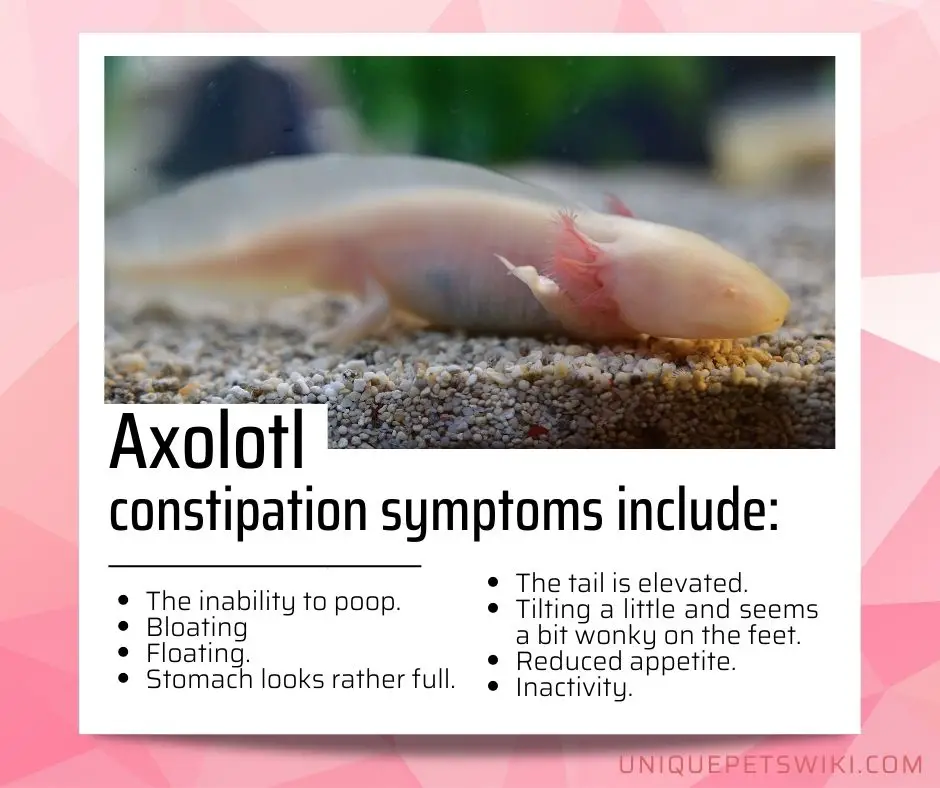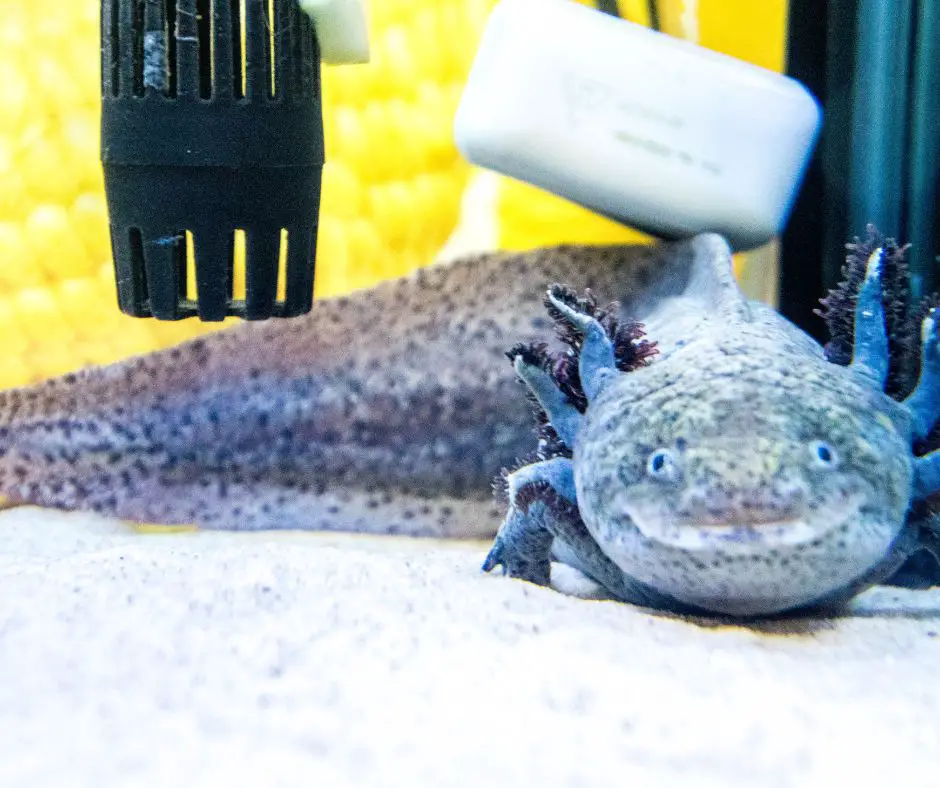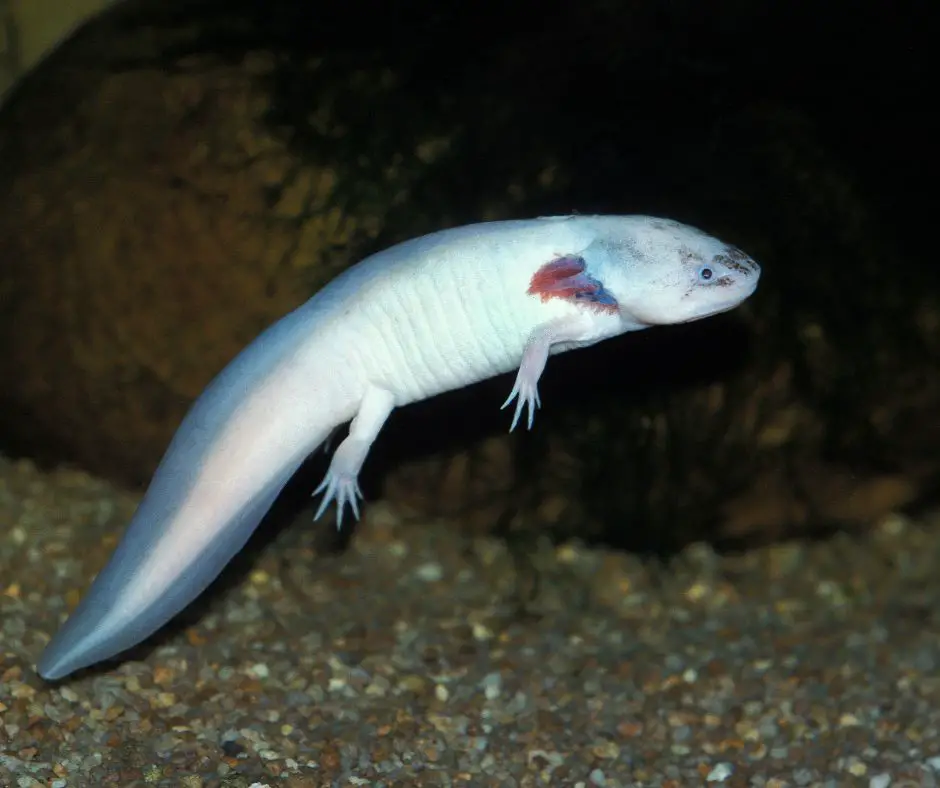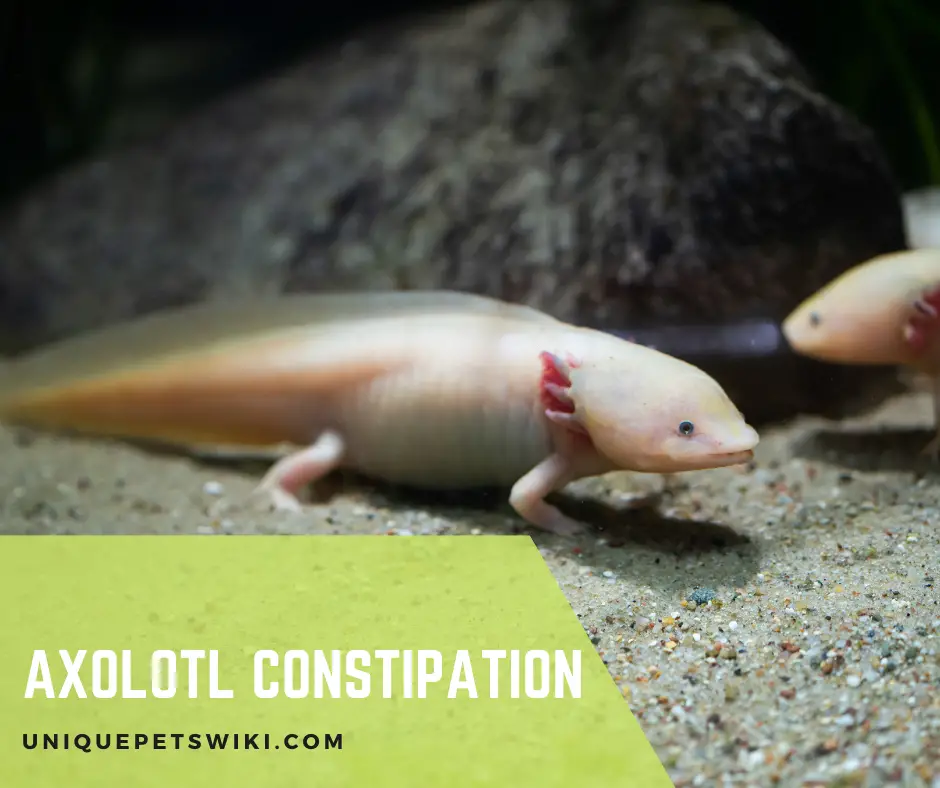Axolotl constipation is not such a common illness or health concern in axolotls as long as your husbandry is ideal. But it does account for many visits to the veterinarian every year.
As a good keeper, you may be tempted to overfeed or even over decorate your axie tank. Yes, these things in one way or the other can causeimpaction/constipation.
For instance, housing your axolotl on sand substrates or small stones isn’t ideal. Your pet is likely to swallow these things as they eat.
These substances (sand, small stones, gravel, plants, etc.) when ingested are indigestible and will cause blockage to their intestinal system. Besides impaction, overfeeding can cause constipation too.
That said, how often should you feed your pet axolotl and what substrates should you use to avoid impaction/constipation?
This article is going to walk you through all you need to know about axolotl constipation, symptoms, and how to treat it. Keep reading to the end.
Contents
Axolotl Constipation Symptoms
Axolotl constipation symptoms include:
- The inability to poop.
- Bloating (abdominal swelling and making it difficult for the Axolotl to move).
- Floating.
- Stomach looks rather full.
- The tail is elevated.
- Tilting a little and seems a bit wonky on the feet.
- Reduced appetite.
- Inactivity.
Constipation isn’t a common issue with axolotls as long as you are feeding them right and housing them in ideal environments.
Typically, axolotls poop 1 – 2 times a week depending on what you feed them, how often/much you feed them, and the water temperature that aids digestion.
That your axolotl is constipated is an indication that something is wrong with either your water temperature, what you’re feeding it, or overfeeding. It could also be that your axolotl is impacted by ingesting stones alongside its food.
Therefore, when you notice that your axolotl hasn’t pooped in 2 weeks, chances are that it’s constipated. The main causes as stated earlier are impaction and overfeeding.
Fortunately, axolotl constipation is easy to treat in its early stages. Thus to detect constipation on time in your axolotl you have to examine it daily, especially a day after feeding.

Axolotl Constipated Cause
Constipation in axolotls is their inability to poop for up to a week or more after eating. Causes include overfeeding and impaction.
Ideally, axolotls poop once or twice a week. But once they’re constipated, they wouldn’t poop for up to two weeks.
Let’s discuss these causes and their symptoms in detail.
Impaction
Impaction occurs when your axolotl eats something it can’t digest or easily pass out or when food is not properly moving through your axolotl’s digestive system.
If something gets stuck, it can result in a constipated axolotl. Ingestion of gravel or small stones by your axolotl is a common cause of impaction.
This commonly occurs when they are housed in a tank with gravel or small stones that they can swallow.
Note that axolotls can swallow anything smaller than their head. They can also get impacted if they swallow any of these things from their tank – chitin, rocks, pieces of fake plants, tank decor, or anything else.
To tell if your axolotl is impacted, watch out for no poop and a swollen abdomen.
Overfeeding
Axolotls are not heavy eaters. But they need a substantial amount of food daily to stay healthy. Baby and juvenile axolotls are to eat daily to enhance their growth. But as adults, they only need food 2 – 3 times a week.
One rule of thumb when feeding axolotls is to feed them as much worms as they can consume. Normally, this is often between 1 – 2 full-sized worms chopped into small sizes that they can swallow.
When you overfeed your axolotls, they find it difficult to digest the food, thus, resulting in constipation. One sure sign that your axolotl is overfed is having a bulging belly.

Axolotl Constipation Treatment
Axolotls are cold-blooded, which means that they rely 100% on their environment to carry out major life activities such as breathing, digesting food, and even remaining active.
Hence, when one or two major requirements for their comfortability are compromised, they tend to develop issues in their health. The earlier you are able to detect it determines whether it can be remedied or not.
So there are 3 main ways to treat axolotl constipation – they are fridging, surgery, and stopping feeding. But these methods depend on two factors – the cause and severity of constipation.
Stop Feeding Them for a Few Days
Since overfeeding is a major cause of constipation, one of the first things you should do when you find out that your axolotl is constipated is to stop feeding it for a few days until you see a poop.
Note that a constipated axolotl still has some undigested food in its system and may appear bulgy/swollen and lethargic.
Hence, when you reduce the portion of food you feed it or stop feeding entirely, it helps the animal digest the one stored in its body so it can poop.
Also, note that axolotls need an ideal water quality/temperature to aid digestion.
Therefore, once you stop feeding it more food, do a daily 100% water change with dechlorinated water. This water change will stimulate it to poop out whatever it has in its system.
When you have done this, observe its behavior. Ensure that the constipation problem is over (that is you have seen some poops) before you start feeding it again. This time feed it properly sized worms.

Fridging
Fridging simply means putting your axolotl in the refrigerator for some time. Fridging is often used in severe illnesses to help in healing. It is not a cure in itself but one of the ways to help your axolotl to recover from an illness.
If you have used the first method discussed earlier, you will not need to fridge your axolotl. Fridging is normally for life or death matters only such as suffering from heat stress, and unless your axolotl appears almost dead, do not fridge it.
The reason is that fridging slows down metabolism although it can prevent undigested food from getting rotten.
This means that if your axolotl constipation is caused by too much undigested food, fridging will prevent the food in the animal’s intestine from getting rotten till it can poop out.
However, some owners said fridging a constipated axolotl will help empty the poop.
One advantage of fridging a constipated axolotl is that it will prevent the undigested food from getting rotten in the system.
Perhaps this way, your constipated axolotl should be able to pass it out afterward. However, if that didn’t help, you’ll need to visit the vet as soon as you can.
The first step in fridging your axolotl is to ensure that the fridge is set within the temperature your axolotl can survive in. for instance, set the temperature of the fridge to between 5°C and 8°C, but no lower than 5°C.
Once you are sure that the temperature is within the ideal range, put your axolotl in a tub before putting it in the fridge.
To transfer your axolotl back to its tank when it’s fully recovered, you need to master How To Fridge Axolotl, the dos and don’ts.
Sistema KLIP IT Rectangular Collection Food Storage Container,236 Oz
- Extra-large food storage container ideal for a variety of foods and ingredients
- Lid with easy-locking clips and extended flexible seal helps keep food fresher for longer
- Modular stacking design and rectangular shape helps save valuable space
- 100% virgin plastic; phthalate- and BPA-free
- Top-rack dishwasher-safe; fridge- and freezer-safe; microwave-safe without lid
Last update on 2022-12-29 / Affiliate links / Images from Amazon Product Advertising API
Surgery
If the first two methods have yielded no results, what you should do next is to take your axolotl to the vet for surgery.
Constipation caused by overfeeding, fridging and not feeding again for some time should resolve it. But impaction caused constipation (where undigestable substances was swallowed), surgery is needed to fix it.
Oftentimes, it’s best to take your axolotl for a veterinarian diagnosis and surgery once you suspect constipation or impaction. This is because the earlier the problem is detected and treated, the better.
Constipation not treated on time can lead to the rotting of food in the animal’s system leading to death.
How to Prevent Constipation in Axolotl
Preventing axolotl constipation is easier than treatment. Since you know what can cause constipation in your axolotl, as a good keeper you must ensure that you eradicate all possible causative factors such as overfeeding and wrong substrates.
Also, always keep an eye on your pet. This way, you can tell when something is wrong with its health on time.
Avoid Impactful Substrates
Substrates such as gravel, small stones, or sand can cause impaction when swallowed. If you don’t have a better substrate to use, you can keep your axolotls without one.
Nonetheless, if you should use sand or small stones as substrates, ensure you feed your axie by hand or in a food dish to avoid swallowing the sand along with the food.
Adjust Feeding Schedule
What you don’t want to do is overfeed your axolotl because this can lead to constipation.
Ideally, adult axolotls need food 2 – 3 times a week and this must be done within 1 – 3 minutes for each mealtime. Leaving worms in the tank for several hours or days will result in overfeeding.
Caribsea Super Naturals Aquarium Sand, 20-Pound
- Create a supernatural experience by re-creating the natural world in your home
- grain size reduces built up detritus
- no paints or dyes used
- ph neutral ; safe for all aquarium systems
- made in the USA
Last update on 2022-12-29 / Affiliate links / Images from Amazon Product Advertising API
FAQs
What does axolotl poop look like?
A healthy axolotl poop looks like a mini goatskin water bottle with brown or black hues. It can as well look like anything from a typical, somewhat elongated brown pellet to wispy, untidy, broken-up fibers.
How to make an axolotl poop?
Review your Axolotl Diet and make sure you are only feeding what you should feed. Stop giving them food for the time being until you notice a poop. You can also consider fridging to help it poop afterward.
How do you treat an axolotl for constipation?
To treat axolotl for constipation you will first need to ascertain what is the cause.
Constipation caused by overfeeding will need you to stop feeding the animal while doing a daily water change to stimulate it to poop.
However, constipation caused by impaction needs fridging/surgery to remove the impacted substances.
Wrapping Up
To some extent, constipation is a common problem in axolotls. But with good care, it shouldn’t be a problem with your axolotls. If you notice that your axolotl has not pooped for up to two weeks, chances are it may be constipated.
There are a few things to look for to know if your axolotl is constipated or not. These include:
- Activity level – is your axie active and exploring or it’s acting lethargic?
- Appetite for food – is your axie still accepting food or not?
- Size of abdomen (if bulky/swollen it tells the presence of undigested food or impacted substances).
When you’re sure your axolotl is constipated via these signs, one of the first things to do before seeing a vet is to stop feeding it.


